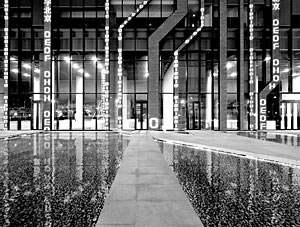Beijing, China
When Zhu Pei and his partner, Wu Tong, began designing Digital Beijing for a site on the western edge of the Olympic Green, the National Swimming Center and National Stadium were already under construction. With such iconic structures—the so-called Water Cube and Bird’s Nest—within sight of their project, they decided to create a building that would act as a foil for the main Olympics venues, rather than try to echo them. (Zhu won the commission when he was a partner at Urbanus, before setting up his own firm in 2005.)
“They are such clean, elegant packages,” says Zhu of the two neighboring buildings, which have received the lion’s share of media attention. “We wanted to design something that was uncultivated, masculine, and authentic,” something that got “to the truth” of what China has become.
Digital Beijing, a nine-story, 1-million-square-foot building, rises solemnly just northwest of the effervescent Water Cube and the curvaceous Bird’s Nest. The building will serve as the control center for the Olympics; home base for technical and security teams; and hub for the routers, computers, and servers needed to run the Games in a digital age. After the Olympics, the building will present high-tech exhibitions in a futuristic space one level below grade where a large, wavelike wall as well as the floor and other walls are all made of translucent polycarbonate. Upstairs, telecom companies such as China Mobile will set up offices in the eastern portion of the building.
Inspired by computer circuitry, Zhu and Wu organized the building into four parallel slabs that recall a set of motherboards. The three western slabs, in fact, house electronic equipment, and the gaps between them provide ventilation for the machinery inside. Windowless elevations on the north and south protect the equipment from daylight. The easternmost slab serves essentially as an office building, accommodating people, not machines. From a distance, the building appears as a somber sentinel clad in gray granite.
But as you get closer, you notice the jazzy vertical ribbons of glass recessed in the west facade and the bands of glass set in the ground that act as horizontal continuations of the ribbons and light up at night. Most people enter the building on the east side—facing the Olympic venues—which Zhu and Wu conceived as the inverse of the west elevation. Here, glass replaces granite as the dominant material, and the zigzagging ribbons of glass have become vertical streams of LEDs.




Post a comment to this article
Report Abusive Comment